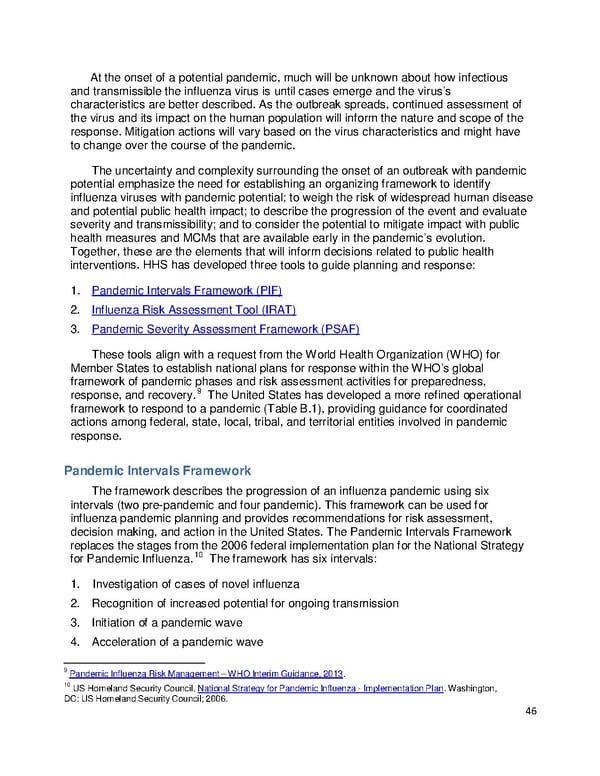At the onset of a potential pandemic, much will be unknown about how infectious and transmissible the influenza virus is until cases emerge and the virus’s characteristics are better described. As the outbreak spreads, continued assessment of the virus and its impact on the human population will inform the nature and scope of the response. Mitigation actions will vary based on the virus characteristics and might have to change over the course of the pandemic. The uncertainty and complexity surrounding the onset of an outbreak with pandemic potential emphasize the need for establishing an organizing framework to identify influenza viruses with pandemic potential; to weigh the risk of widespread human disease and potential public health impact; to describe the progression of the event and evaluate severity and transmissibility; and to consider the potential to mitigate impact with public health measures and MCMs that are available early in the pandemic’s evolution. Together, these are the elements that will inform decisions related to public health interventions. HHS has developed three tools to guide planning and response: 1. Pandemic Interv als Framework (PIF) 2. Influenza Risk Assessment Tool (IRAT) 3. Pandemic Severity Assessment Framework (PSAF) These tools align with a request from the World Health Organization (WHO) for Member States to establish national plans for response within the WHO’s global framework of pandemic phases and risk assessment activities for preparedness, 9 response, and recovery. The United States has developed a more refined operational framework to respond to a pandemic (Table B.1), providing guidance for coordinated actions among federal, state, local, tribal, and territorial entities involved in pandemic response. Pandemic Intervals Framework The framework describes the progression of an influenza pandemic using six intervals (two pre-pandemic and four pandemic). This framework can be used for influenza pandemic planning and provides recommendations for risk assessment, decision making, and action in the United States. The Pandemic Intervals Framework replaces the stages from the 2006 federal implementation plan for the National Strategy for Pandemic Influenza.10 The framework has six intervals: 1. Investigation of cases of novel influenza nition of increased potential for ongoing transmission 2. Recog demic wave 3. Initiation of a pan 4. Acceleration of a pandemic wave 9 Pandemic Influenza Risk Management – WHO Interim Guidance, 2013. 10 US Homeland Security Council. National Strategy for Pandemic Influenza - Implementation Plan. Washington, DC: US Homeland Security Council; 2006. 46
 Pandemic Influenza Plan Page 45 Page 47
Pandemic Influenza Plan Page 45 Page 47